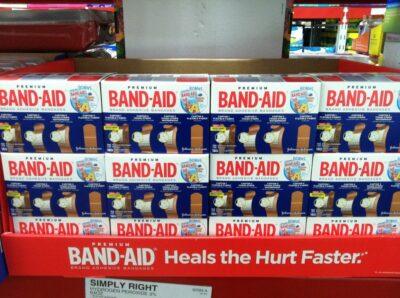Living off the grid often puts us into some fairly remote locations. That can make a routine trip to a drug store a major undertaking if we need something for immediate relief from pain, an illness or injury. It can become particularly problematic if you are living in a region that has been subject to a natural or man-made disaster. For not a lot of money, and with a bit of pre-planning, you can easily stockpile a good assortment of over-the-counter remedies that should handle some of the everyday conditions or emergencies you could encounter, and some significant events as well. (For a list of essential oils to stockpile, click here.)
At times throughout this article, specific medicines are referred to by their common brand name, but you should probably consider the generics as an alternative. Generic versions of most medicines are less expensive and typically have the same ingredients and proportions. How and when you purchase these items depends on your disposable income and your location. Most are available through the Internet, but can be easily found in any pharmacy or grocery store. Buying this full list all at once can add up, so you could always purchase a few items when you shop and slowly build up your inventory. The items are presented with some sense of priority, starting with pain relievers and moving down the list to conditions or injuries that are statistically less likely to occur.
If you have children, keep in mind that many over-the-counter medicines are available in children’s dosages. If you understand what a child’s dose should be, you could potentially reduce the dosage of an adult version, but make sure you know exactly how to reduce the dosage. Cutting a pill in half is an easy way to halve the dosage, but what do you do if it’s a caplet filled with a powder-like substance?
Pain Relief
It’s about more than a headache. Many injuries, illnesses and conditions create varying levels of pain, and pain relief helps. Keep a careful eye on recommended dosages and think about alternating types of pain relievers based on dosage times to see if one does better than the other. Aspirin is the standard pain reliever, but ibuprofen also has some benefits related to inflammation due to an injury. There are also topical pain relievers such as anesthetic sprays like Bactine or Solarcaine that can provide relief for minor burns and scrapes or conditions that cause itching. A product like Cortisone-10 also can provide relief for these kinds of conditions.
- Aspirin
- Ibuprofen
- Acetaminophen
- Bactine spray
- Corizone-10 or generic
The Hidden Secrets Of Making Herbal Medicines…Right At Your Fingertips!
Topical Antibiotics
The most common cause of infections is due to simple wounds in the skin that allow bacteria to enter the bloodstream. It’s difficult to treat any infection without prescription antibiotics, but an OTC, topical antibiotic can go a long way toward preventing infection in the first place. The best may be a triple-antibiotic such as Neosporin, but here again there are generic versions that are equally effective. First-aid creams can also work, but they usually lack the triple combination of bacitracin, neomycin, and polymyxin B that are the most effective against bacteria on the skin. Iodine is also effective but creates a sharp, burning sensation when used.
- Neosporin or generic triple antibiotic
- First-aid cream
- Iodine
Bandages and Wound Dressing
It happens all the time. We cut ourselves with a knife, an ax or saw, or a random piece of metal that just seems to cut across us just right. Wounds that require bandages can be serious if there is profuse bleeding. That’s why it’s wise to have large gauze pads on hand. Bandages both large and small are equally important.
Large bandages with the adhesive strips attached are also a good idea if someone has a sizable wound. Remember, too, that gauze rolls are worth having around to help with wrapping a bandage around an arm, leg, foot, hand or finger. In a pinch, you could always buy a first-aid kit which will usually feature a variety of bandages, although the larger sizes are sometimes missing. Grab a roll of first-aid tape while you’re at it. It helps with the larger gauze bandages.
- Gauze pads
- Band-aid strips
- Large bandages
- Gauze rolls
- First-aid tape
Burns
Burns can be very serious and can also lead to infection. There are burn kits that can be purchased without a prescription that contain burn creams, topical antibiotics and specially designed bandages developed specifically for burns. These bandages are saturated with antibiotics and lidocaine for topical pain relief. You can also find some of these items on the shelf, but they can be obscure and it seems that only the larger pharmacies carry a range of burn first-aid products.
- Burn cream
- Petroleum jelly
- Non-stick antiseptic gauze
Orthopedic Relief
Many of us have hobbled around on a sprained ankle or knee, and put up with the pain of an injured arm or wrist. While pain relievers help, sometimes we need the added support and re-enforcement of a physical brace or wrap. Some of the braces can be a bit expensive in the $20 to $30 range, but if you ever have such an injury make sure you hold on to that knee or wrist brace for future use. Some orthopedic support can be improvised with elastic wraps and a sling improvised from a pillow case or baby-diaper, but that’s up to you.
- Knee and ankle braces
- Elastic wraps
- Wrist brace
- Finger splints
- Arm sling
Eye care
An eye injury can be as debilitating as a severe toothache. If our eyes are irritated, injured or scratched, the response falls somewhere between pain and panic. Pain relief is a critical consideration; a sterile washcloth soaked in warm water and held over the closed eye can help. From an OTC standpoint, a saline solution to rinse and disinfect the eye is worth considering, along with eye drops, an eye salve which is intended to be used with a soft, cotton eye pad and held in place with either first-aid tape or an eye patch.
- Saline solution
- Eye drops
- Eye salve
- Eye pads
- Eye patches
Dental
Here’s one we don’t think about as much as we should. A severe toothache or injury to our teeth can make life miserable. There are various things you can assemble to aid any dental problems you have, or you can purchase a dental medical kit with both instructions and some necessary tools and supplies.
- Floss
- Cotton
- Oral aesthetic such as Orajel or Anbesol
- Temporary cavity filling mixture
- Dental wax
- Dental pick
Respiratory Relief
Coughs and sinus congestion are typically the signs of a cold or virus, although allergies can also be a cause. Depending on your family’s overall health, you can consider a range of medicines for respiratory relief. An inhaler can be bought over-the-counter to help with a chronic cough. A cough suppressant can also help to reduce coughing, while a cough-expectorant helps to get fluid and mucous out of the lungs and nasal passages.
New “Survival Herb Bank” Gives You Access to God’s Amazing Medicine Chest
Nasal sprays can also help with sinus congestion, but use them as directed and don’t share them. You’ll just be passing around the cold. There are throat sprays that provide some topical relief for a severe sore throat. If you or a family member succumbs to allergies, Benadryl or a generic antihistamine could also offer some relief.
- Inhaler
- Cough suppressant
- Cough expectorant
- Mucous relief tablets
- Nasal spray
- Throat spray
- Benadryl or generic antihistamines
Gastro-intestinal distress
Diarrhea and vomiting can lead to dehydration and generally make us feel exhausted. While Tums or Rolaids or other antacids can help with indigestion, more potent medicines like Emetrol can help to relieve vomiting, while Kaopectate and Pepto-Bismol can relieve diarrhea to some degree. Zantac is somewhat expensive and there are generics for all of these medicines, but if you have a severe problem with indigestion you might want to have some in the medicine cabinet.
- Tums or Rolaids
- Emetrol
- Pepto-Bismol
- Kaopectate
- Zantac
Antiseptic disinfectants
Disinfectants are used for cleaning surfaces, first-aid equipment, skin or any other objects or items that could potentially lead to bacterial growth and infection. Some are especially potent, such as iodine and bleach, although bleach is never intended for use on skin or open wounds. Iodine will burn if it enters an open wound, while hydrogen peroxide is gentler and also a strong disinfectant. Many people know that vinegar is a powerful germ-killer and disinfectant, and in an emergency can be used to treat skin or open wounds if no other antiseptics are available.
- Iodine
- Hydrogen peroxide
- White vinegar
- Bleach
Are there other OTC items you might consider? Of course, but that depends on your situation, your disposition and your location. Iodine tablets are OTC and are intended to protect the thyroid gland in the event of a nuclear incident and radiation. Ipecac syrup causes vomiting and is often used in cases of accidental poisoning. It all gets back to the statistical possibilities of an event or condition. If you live in a place or with a mindset that indicates high-risk from a variety of possibilities, you might want to expand your inventory and consider additional OTC solutions.
What would you add to this list? Share you tips in the section below:
 Off The Grid News Better Ideas For Off The Grid Living
Off The Grid News Better Ideas For Off The Grid Living







